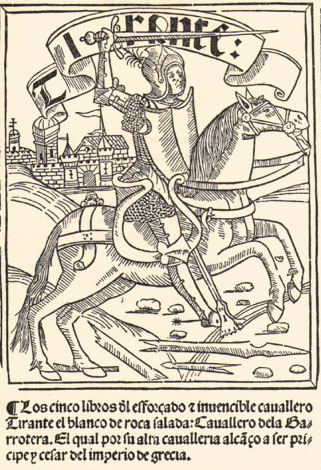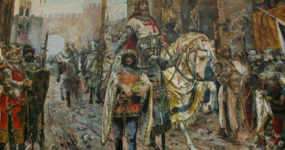First published in Valencia in 1490, ‘Tirant lo Blanc’ (or Blanch in the original medieval spelling) is the iconic Valencian novel par excellence. It was the first Spanish chivalry romance to be published and according to the Spanish National Library “the most read book in medieval Europe”. It was written by Valencian courtier Joanot Martorell who wasn’t averse to a bit of swordplay himself. The book is recognised as being hugely influential in the development of the modern novel and was an inspiration to both Cervantes and Shakespeare. Of course, this being Valencia, for the average Valencian in the street the burning issue is making sure everyone knows that it is a Valencian and not a Catalan book as some might have us believe.
The novel follows the adventures of Breton knight Tirant lo Blanc who, like a Middle Ages version of James Bond (without gadgets), rushes around the medieval world from England to Rhodes, from Constantinople to North Africa and even to Persia, doing chivalrous deeds, fighting the baddies, wooing the ladies and making wry sarcastic comments at every opportunity. The key to the book is that, unlike much of the huge library of chivalric novels that followed in its wake, it is not just a romantic fairytale of sword and sorcery. Although fictitious, the stories are human and believable often based on real events and the exploits of real historical figures like the knight Roger de Lauria.
Tirant lo Blanc uses no magic or superhuman powers and he is genuinely bricking it before the big battle with the Sultan of Cairo. The novel also depicts aspects of mundane, rough-and-ready medieval life and portrays characters of all classes and social rank. It was this authenticity that interested later writers like Cervantes and Shakespeare. Shakespeare is generally acknowledged to have used scenes and themes from the book, particularly in ‘Much Ado About Nothing’, and in the book burning scene in ‘Don Quixote’, ‘Tirant lo Blanc’ is the only book saved. Cervantes writes ‘‘By right of its style, ‘Tirant lo Blanch’ is the best book in the world. Here knights eat, sleep and die and make their will, things that the rest of the books of this genre lack.’’ The book was certainly ahead of its time and laid some of the ground rules for the classic European novel.
Joanot Martorell was born to a Valencian noble family around 1410. The family were well connected both at the Valencian court and in Valencian academic circles, his sister married the poet Ausiàs March. Letters from the time are testament to Martorell’s intelligence and acerbic wit but he was just as ready to threaten to use his sword to sort out any arguments.
Throughout his life he was involved in numerous disputes, brawls and sometimes even duels although, as was typical of most nobles of the time, it mostly consisted of bold verbal challenges without anyone actually getting close to being hit over the head with a mace. Much of his verbal vitriol was aimed at his cousin, Joan de Monpalau, who had jilted his sister Damiata at the altar. In letters now exhibited in the Spanish National Library they challenge each other to all manner of duels, battles and even a jousting match. All of this in beautiful, flowery, erudite language, some of the most eloquent ‘‘Come and have a go if you think you’re hard enough’’ talk ever committed to paper.
Cultured and well-educated, Martorell travelled extensively, rubbing shoulders with the aristocracy in the courts of Europe, first to Naples and Portugal and then in 1438 to London. It was there that the befriended the English King Henry VI who agreed to adjudicate a duel between Martorell and his archenemy Monpalau. In any event, Monpalau was all talk and no trousers and never turned up. Martorell was awarded compensation. Henry VI also presided over another of the hot-headed writer’s duels, on this occasion with another Valencian at the English court, Perot Mercader. This time, to everyone’s shock (not least that of Martorell), the duel actually took place with Martorell seriously wounding his adversary. In 1442, he left the English court and returned to Valencia where he continued his lifelong series of disputes and scrapes with half of the Valencian aristocracy including Gonzalo de Hijar and his own brother-in-law Ausiàs March. Well travelled and well versed in all the paraphernalia of knighthood, Martorell drew heavily on his experiences for his writing. He died an untimely death in Valencia in 1468 and on his deathbed he entrusted the completion and editing of the unfinished ‘Tirant lo Blanc’ to his friend Marti Joan de Galba. The book was finally published to great acclaim some twenty years after his death.
And so on to the controversy. In the last thirty years, some Catalan publications and intellectuals have claimed ‘Tirant lo Blanc’ as a Catalan novel as it is written in the Catalan language. Simple really, or perhaps not. Such claims have not always gone down too well in these parts. There are people round here who would argue that it’s a book written by a Valencian, edited by another Valencian and first published in Valencia. The argument, as ever, boils down to language and it’s difficult to dispute the total similarities between Valencian and Catalan, especially at the time the book was written, but Mark Twain, for example, wrote in English and no one would describe him as an English writer. Martorell himself said in one of his letters that he wrote ‘‘in the Valencian Vernacular’’.
As is often the case, it’s a shame that sometimes the bickering overshadows the importance and beauty of the book itself. Anyway, it may all be of little importance since while he was in England, Martorell translated a biography of the English knight ‘Guy of Warwick’ into French. The book was lent to him by his friend King Henry VI and is now kept in the reading room of the British Museum. The book inspired Martorell and he based a lot of ‘Tirant lo Blanc’ on the life of Warwick, especially in the first part of the book. So you could argue that Martorell’s book is actually more English than it is Catalan. Of course, personally speaking, ‘‘Jo m’en in fot’’.
If you fancy reading it, ‘Tirant lo Blanc’ is still available in Valencian-Catalan, Spanish and English. A film of the book was released in 2005.
David Rhead and José Marin
Related Post
This site uses Akismet to reduce spam. Learn how your comment data is processed.

























Leave a comment